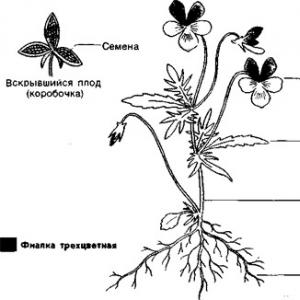Where all types of RNA are formed. Structure and functions of RNA. Transport ribonucleic acid
RNA- a polymer whose monomers are ribonucleotides. Unlike DNA, RNA is formed not by two, but by one polynucleotide chain (with the exception that some RNA-containing viruses have double-stranded RNA). RNA nucleotides are capable of forming hydrogen bonds with each other. RNA chains are much shorter than DNA chains.
RNA monomer - nucleotide (ribonucleotide)- consists of residues of three substances: 1) a nitrogenous base, 2) a five-carbon monosaccharide (pentose) and 3) phosphoric acid. The nitrogenous bases of RNA also belong to the classes of pyrimidines and purines.
The pyrimidine bases of RNA are uracil, cytosine, and the purine bases are adenine and guanine. The RNA nucleotide monosaccharide is ribose.
Highlight three types of RNA: 1) informational(messenger) RNA - mRNA (mRNA), 2) transport RNA - tRNA, 3) ribosomal RNA - rRNA.
All types of RNA are unbranched polynucleotides, have a specific spatial conformation and take part in the processes of protein synthesis. Information about the structure of all types of RNA is stored in DNA. The process of synthesizing RNA on a DNA template is called transcription.

Transfer RNAs usually contain 76 (from 75 to 95) nucleotides; molecular weight - 25,000–30,000. tRNA accounts for about 10% of the total RNA content in the cell. Functions of tRNA: 1) transport of amino acids to the site of protein synthesis, to ribosomes, 2) translational intermediary. There are about 40 types of tRNA found in a cell, each of them has a unique nucleotide sequence. However, all tRNAs have several intramolecular complementary regions, due to which the tRNAs acquire a clover-leaf-like conformation. Any tRNA has a loop for contact with the ribosome (1), an anticodon loop (2), a loop for contact with the enzyme (3), an acceptor stem (4), and an anticodon (5). The amino acid is added to the 3" end of the acceptor stem. Anticodon- three nucleotides that “identify” the mRNA codon. It should be emphasized that a specific tRNA can transport a strictly defined amino acid corresponding to its anticodon. The specificity of the connection between amino acid and tRNA is achieved due to the properties of the enzyme aminoacyl-tRNA synthetase.
Ribosomal RNA contain 3000–5000 nucleotides; molecular weight - 1,000,000–1,500,000. rRNA accounts for 80–85% of the total RNA content in the cell. In complex with ribosomal proteins, rRNA forms ribosomes - organelles that carry out protein synthesis. In eukaryotic cells, rRNA synthesis occurs in the nucleoli. Functions of rRNA: 1) necessary structural component ribosomes and thus ensuring the functioning of ribosomes; 2) ensuring the interaction of the ribosome and tRNA; 3) initial binding of the ribosome and the initiator codon of the mRNA and determination of the reading frame, 4) formation of the active center of the ribosome.
Primary structure of RNA – the order of alternation of ribonucleoside monophosphates in the polynucleotide chain. In RNA, as in DNA, nucleotides are linked to each other by 3",5" phosphodiester bonds. The ends of the RNA polynucleotide chains are not the same. At one end there is a phosphorylated OH group of the 5" carbon atom, at the other end there is an OH group of the 3" carbon atom of ribose, therefore the ends are called the 5" and 3" ends of the RNA chain.
Secondary structure of RNA
A ribonucleic acid molecule is made up of a single polynucleotide chain. Individual sections of the RNA chain form helical loops - “hairpins”, due to hydrogen bonds between complementary nitrogenous bases A-U and G-C. Parts of the RNA chain in such helical structures are antiparallel, but not always completely complementary; they contain unpaired nucleotide residues or even single-stranded loops that do not fit into the double helix. The presence of helical regions is characteristic of all types of RNA.
Tertiary structure of RNA
Single-stranded RNAs are characterized by a compact and ordered tertiary structure, which arises through the interaction of helical elements of the secondary structure. Thus, it is possible to form additional hydrogen bonds between nucleotide residues that are sufficiently distant from each other, or bonds between the OH groups of ribose residues and bases. The tertiary structure of RNA is stabilized by divalent metal ions, such as Mg ions 2+ , binding not only to phosphate groups, but also to bases.
Main types of RNA
There are 3 types of ribonucleic acids in the cytoplasm of cells - transfer RNA (tRNA), messenger RNA (mRNA) and ribosomal RNA (rRNA). They differ in primary structure, molecular weight, conformation, life span and, most importantly, functional activity.
http :// www . biochemistry . ru / biohimija _ severina / B 5873 Part 25-141. html
Methods for determining the primary and secondary structure of nucleic acids
Sequencing is the general name for methods that allow you to determine the sequence of nucleotides in a DNA molecule. There is currently no sequencing method that works for an entire DNA molecule; they all work like this: first, a large number of small sections of DNA are prepared (the DNA molecule is cloned many times and “cut” in random places), and then each section is read separately.
Cloning occurs either by simply growing cells in a Petri dish, or (in cases where this would be too slow or for some reason would not work) using the so-called polymerase chain reaction. Briefly and imprecisely, it works something like this: first, the DNA is denatured, i.e. break hydrogen bonds to form individual strands. So-called primers are then attached to the DNA; these are short sections of DNA to which DNA polymerase can attach - a compound that, in fact, is involved in copying (replication)DNA strands. At the next stage, the polymerase copies the DNA, after which the process can be repeated: after a new denaturation, there will be twice as many individual strands, in the third cycle – four times, and so on.
All these effects are achieved mainly by changing the temperature of the mixture of DNA, primers and polymerase; For our purposes, it is important that this is a fairly accurate process, errors are rare, and the output is a large number of copies of sections of the same DNA. Different sequencing methods differ from each other not in cloning methods, but in how they then read the resulting “soup” of multiple copies of the same DNA.
DNA-DNA hybridization method is based on the fact that the stability of DNA-DNA duplexes at a certain temperature depends on the number of nucleotides forming complementary pairs. It is obvious that the number of complementary nucleotides in a duplex where both strands originate from the same DNA molecule (i.e. in homoduplexes) is 100%. If both strands have different origins (heteroduplex), then, depending on the number of mutations that have occurred, the number of complementary pairs will be less than 100%. Accordingly, heteroduplexes should decompose (melt) at a lower temperature than homoduplexes. Moreover, the lower the melting temperature, the greater the differences in the two sequences. The temperature stability of hybrid DNA is determined by the temperature at which 50% of the hybrid DNA has dissociated into a single-stranded form. This temperature is then compared to the average 50% melting temperature of homoduplexes of both types of sequences involved in heteroduplex formation, this temperature is usually designated Tm. The difference between the median melting temperatures of hetero- and homoduplexes is denoted as dTm. A linear dependence of dTm on the number of unpaired bases is shown (Britten et. al., 1974): p=cdTm. The constant c is usually determined by the experimental conditions and usually varies from 0.01 to 0.015. Determining dTm requires a large number of repetitions, because large experimental error.
The main property of DNA is its ability to replicate.
http :// postscience . ru / longreads /468
1.9. DNA replication, transcription, translation, reverse transcription. DNA amplification. Protein biosynthesis, amino acid code. Organization of genes, structure of genes in pro- and eukaryotes, concept of cloning.
Replication is a process of self-duplication of DNA molecules that occurs under the control of enzymes. Replication occurs before each nuclear division. It begins with the DNA helix temporarily unwinding under the action of the enzyme DNA polymerase. On each of the chains formed after the rupture of hydrogen bonds, a daughter DNA strand is synthesized according to the principle of complementarity. The material for synthesis are free nucleotides that are present in the nucleus.
DNA replication scheme
Thus, each polynucleotide chain acts as a template for a new complementary chain (therefore, the process of doubling DNA molecules belongs to template synthesis reactions). The result is two DNA molecules, each of which has one chain left from the parent molecule (half), and the other newly synthesized. Moreover, one new chain is synthesized continuous, and the second - first in the form of short fragments, which are then stitched into a long chain by a special enzyme - DNA ligase. As a result of replication, the two new DNA molecules are an exact copy of the original molecule.
Biological meaning of replication consists in the accurate transfer of hereditary information from the mother cell to the daughter cells, which occurs during the division of somatic cells.
http :// sbio . info / page . php ? id =11
Literature:
1) N. Green, W. Stout, D. Taylor - Biology.
2) Z.A. Shabarova and A.A. Bogdanov – Chemistry of nucleic acids and their polymers.
3) A.P. Pekhov – Biology and general genetics.
4) A. Mickelson – Chemistry of nucleosides and nucleotides.
5) Z. Hauptmann, J. Graefe, H. Remane – Organic chemistry
Transcription is a process of synthesisRNAusingDNAas a matrix, occurring in all living cells. In other words, it is the transfer of genetic information from DNA to RNA.
Transcriptioncatalyzed enzymeDNA-dependent RNA polymerase. The process of RNA synthesis proceeds in the direction from the 5" to the 3" end, that is, along the DNA template strandRNA polymerasemoves in the direction of 3" - 5".
Transcription consists of the stages of initiation, elongation and termination. The unit of transcription is the transcripton, a fragment of a DNA molecule consisting of a promoter, a transcribed part, and a terminator.
Initiation of transcription is a complex process that depends on the DNA sequence near the transcribed sequence (andeukaryotesalso from more distant parts of the genome -enhancersAndsilencers) and on the presence or absence of variousprotein factors.
Transcription elongation
The moment at which RNA polymerase transitions from transcription initiation to elongation is not precisely determined. Three main biochemical events characterize this transition in the case of RNA polymerasecoli: sigma factor department, firsttranslocationmoleculesenzymealong the matrix and strong stabilization of the transcription complex, which, in addition to RNA polymerase, includes the growing RNA chain and transcribed DNA. The same phenomena are also characteristic of eukaryotic RNA polymerases. The transition from initiation to elongation is accompanied by the breaking of bonds between the enzyme,promoter, transcription initiation factors, and in some cases – the transition of RNA polymerase to a state of elongation competence. The elongation phase ends after the growing transcript is released anddissociationenzyme from the matrix (termination).
At the elongation stage inDNAapproximately 18 pairs unbraidednucleotides. About 12 nucleotides of the DNA template strand forms a hybrid helix with the growing end of the RNA strand. As RNA polymerase moves through the template, unwinding of the DNA double helix occurs ahead of it, and restoration of the DNA double helix occurs behind it. At the same time, the next link of the growing RNA chain is released from the complex with the template and RNA polymerase. These movements must be accompanied by relative rotation of RNA polymerase and DNA.
Molecular biology is one of the most important branches of biological sciences and involves a detailed study of the cells of living organisms and their components. Her research includes many vital important processes such as birth, breathing, growth, death.
An invaluable discovery molecular biology began to decipher the genetic code of higher beings and determine the ability of a cell to store and transmit genetic information. The main role in these processes belongs to nucleic acids, of which in nature there are two types - DNA and RNA. What are these macromolecules? What are they made of and what biological functions do they perform?
What is DNA?
DNA stands for deoxyribonucleic acid. It is one of the three macromolecules of the cell (the other two are proteins and ribonucleic acid), which ensures the preservation and transmission of the genetic code for the development and activity of organisms. In simple words, DNA is the carrier of genetic information. It contains the genotype of an individual, which has the ability to reproduce itself and transmits information by inheritance.
How Chemical substance acid was isolated from cells back in the 1860s, but until the middle of the 20th century no one imagined that it was capable of storing and transmitting information. 
For a long time it was believed that these functions were performed by proteins, but in 1953 a group of biologists was able to significantly expand the understanding of the essence of the molecule and prove the primary role of DNA in the preservation and transmission of the genotype. The find became the discovery of the century, and scientists received for their work Nobel Prize.
What does DNA consist of?
DNA is the largest of biological molecules and consists of four nucleotides consisting of a phosphoric acid residue. Structurally, the acid is quite complex. Its nucleotides are connected to each other by long chains, which are combined in pairs into secondary structures - double helices.
DNA tends to be damaged by radiation or various oxidizing substances, due to which a mutation process occurs in the molecule. The functioning of the acid directly depends on its interaction with another molecule - proteins. By interacting with them in the cell, it forms the substance chromatin, within which information is realized.
What is RNA?
RNA is a ribonucleic acid containing nitrogenous bases and phosphoric acid residues. 
There is a hypothesis that it is the first molecule that acquired the ability to reproduce itself back in the era of the formation of our planet - in pre-biological systems. RNA is still included in the genomes of individual viruses today, fulfilling the role in them that DNA plays in higher beings.
Ribonucleic acid consists of 4 nucleotides, but instead of a double helix, as in DNA, its chains are connected by a single curve. Nucleotides contain ribose, which takes Active participation in metabolism. Depending on their ability to encode protein, RNA is divided into template and non-coding.
The first acts as a kind of intermediary in the transfer of encoded information to ribosomes. The latter cannot encode proteins, but have other capabilities - translation and ligation of molecules.
How is DNA different from RNA?
In my own way chemical composition acids are very similar to each other. Both are linear polymers and are N-glycosides created from five-carbon sugar residues. The difference between them is that the sugar residue of RNA is ribose, a monosaccharide from the pentose group, easily soluble in water. The sugar residue in DNA is deoxyribose, or a derivative of ribose, which has a slightly different structure. 
Unlike ribose, which forms a ring of 4 carbon atoms and 1 oxygen atom, in deoxyribose the second carbon atom is replaced by hydrogen. Another difference between DNA and RNA is their size - larger. In addition, among the four nucleotides included in DNA, one is a nitrogenous base called thymine, while in RNA, instead of thymine, there is a version of it - uracil.
If previously the prevailing opinion was that RNA played a minor role, it is now clear that it is a necessary and essential element of cell life. Mechanisms of many...
From Masterweb
09.04.2018 14:00Various types of DNA and RNA - nucleic acids - are one of the objects of study of molecular biology. One of the most promising and rapidly developing areas in this science is last years was RNA research.
Briefly about the structure of RNA
So, RNA, ribonucleic acid, is a biopolymer, the molecule of which is a chain formed by four types of nucleotides. Each nucleotide, in turn, consists of a nitrogenous base (adenine A, guanine G, uracil U or cytosine C) combined with the sugar ribose and a phosphoric acid residue. Phosphate residues, combining with ribose of neighboring nucleotides, “crosslink” the constituent blocks of RNA into a macromolecule - a polynucleotide. This is how it is formed primary structure RNA.
The secondary structure - the formation of a double chain - is formed in some parts of the molecule in accordance with the principle of complementarity of nitrogenous bases: adenine forms a pair with uracil through a double, and guanine with cytosine - a triple hydrogen bond.
In its working form, the RNA molecule also forms a tertiary structure - a special spatial structure, conformation.
RNA synthesis
All types of RNA are synthesized using the enzyme RNA polymerase. It can be DNA- and RNA-dependent, that is, it can catalyze synthesis on both DNA and RNA templates.
The synthesis is based on base complementarity and antiparallel direction of reading the genetic code and proceeds in several stages.
First, RNA polymerase is recognized and binds to a special sequence of nucleotides on DNA - the promoter, after which the double helix of DNA unwinds in a small area and the assembly of an RNA molecule begins over one of the chains, called the template (the other DNA chain is called coding - it is its copy that is synthesized RNA). The asymmetry of the promoter determines which DNA strand will serve as a template, and thereby allows RNA polymerase to initiate synthesis in the correct direction.
The next stage is called elongation. The transcription complex, including RNA polymerase and the untwisted region with the DNA-RNA hybrid, begins to move. As this movement proceeds, the growing RNA chain gradually separates, and the DNA double helix unwinds in front of the complex and is restored behind it.

The final stage of synthesis occurs when RNA polymerase reaches a special region of the template called the terminator. Termination (completion) of the process can be achieved in various ways.
Main types of RNA and their functions in cells
They are as follows:
- Matrix or information (mRNA). Through it, transcription is carried out - the transfer of genetic information from DNA.
- Ribosomal (rRNA), which ensures the process of translation - protein synthesis on an mRNA matrix.
- Transport (tRNA). Recognizes and transports amino acids to the ribosome, where protein synthesis occurs, and also takes part in translation.
- Small RNAs are a large class of small molecules that perform various functions during the processes of transcription, RNA maturation, and translation.
- RNA genomes are coding sequences that contain genetic information in some viruses and viroids.
In the 1980s, the catalytic activity of RNA was discovered. Molecules with this property are called ribozymes. Not many natural ribozymes are known yet; their catalytic ability is lower than that of proteins, but in the cell they perform extremely important functions. Currently, successful work is underway on the synthesis of ribozymes, which also have practical significance.
Let's take a closer look at the different types of RNA molecules.
Messenger (messenger) RNA
This molecule is synthesized over an untwisted section of DNA, thus copying the gene encoding a particular protein.
The RNA of eukaryotic cells, before becoming, in turn, a matrix for protein synthesis, must mature, that is, go through a complex of various modifications - processing.
First of all, even at the transcription stage, the molecule is capped: a special structure of one or more modified nucleotides – a cap – is attached to its end. It plays an important role in many downstream processes and increases mRNA stability. The so-called poly(A) tail, a sequence of adenine nucleotides, is attached to the other end of the primary transcript.
The pre-mRNA then undergoes splicing. This is the removal from the molecule of non-coding regions - introns, of which there are many in eukaryotic DNA. Next, the mRNA editing procedure occurs, during which its composition is chemically modified, as well as methylation, after which the mature mRNA leaves the cell nucleus.

Ribosomal RNA
The basis of the ribosome, a complex that ensures protein synthesis, is made up of two long rRNAs, which form ribosomal subparticles. They are synthesized together in the form of one pre-rRNA, which is then separated during processing. The large subparticle also includes low molecular weight rRNA, synthesized from a separate gene. Ribosomal RNAs have a tightly packed tertiary structure that serves as a scaffold for proteins present in the ribosome that perform auxiliary functions.
In the idle phase, the ribosomal subunits are separated; When the translation process is initiated, the rRNA of the small subparticle combines with the messenger RNA, after which the elements of the ribosome are completely combined. When the RNA of a small subunit interacts with mRNA, the latter is pulled through the ribosome (which is equivalent to the movement of the ribosome along the mRNA). The ribosomal RNA of the large subunit is a ribozyme, that is, it has enzymatic properties. It catalyzes the formation of peptide bonds between amino acids during protein synthesis.

It should be noted that the largest portion of all RNA in a cell is ribosomal - 70-80%. DNA has big amount genes encoding rRNA, which ensures its very intense transcription.
Transfer RNA
This molecule is recognized by a specific amino acid with the help of a special enzyme and, combining with it, transports the amino acid to the ribosome, where it serves as an intermediary in the process of translation - protein synthesis. Transfer occurs by diffusion in the cytoplasm of the cell.
Newly synthesized tRNA molecules, like other types of RNA, undergo processing. Mature tRNA in its active form has a cloverleaf-like conformation. On the “petiole” of the leaf - the acceptor site - there is a CCA sequence with a hydroxyl group that binds to the amino acid. At the opposite end of the “leaf” is an anticodon loop that binds to the complementary codon on the mRNA. The D-loop serves to bind transfer RNA to the enzyme when interacting with an amino acid, and the T-loop serves to bind to the large subunit of the ribosome.

Small RNAs
These types of RNA play an important role in cellular processes and are now being actively studied.
For example, small nuclear RNAs in eukaryotic cells are involved in mRNA splicing and possibly have catalytic properties along with spliceosomal proteins. Small nucleolar RNAs are involved in the processing of ribosomal and transfer RNA.
Small interfering and microRNAs are the most important elements of the gene expression regulation system necessary for the cell to control its own structure and vital functions. This system is an important part of the cell's immune antiviral response.
There is also a class of small RNAs that function in complex with Piwi proteins. These complexes play a huge role in the development of germline cells, spermatogenesis and the suppression of mobile genetic elements.
RNA genome
The RNA molecule can be used as a genome by most viruses. Viral genomes are different - single- and double-stranded, circular or linear. Also, RNA virus genomes are often segmented and generally shorter than DNA genomes.
There is a family of viruses whose genetic information, encoded in RNA, after infecting a cell is reverse transcribed into DNA, which is then inserted into the genome of the victim cell. These are so-called retroviruses. These include, in particular, the human immunodeficiency virus.

The importance of RNA research in modern science
If previously the prevailing opinion was that RNA played a minor role, it is now clear that it is a necessary and essential element of intracellular life. Many processes of primary importance cannot occur without the active participation of RNA. Mechanisms of such processes for a long time remained unknown, but thanks to research various types Many details are gradually becoming clearer about RNA and their functions.
It is possible that RNA played a decisive role in the emergence and development of life at the dawn of Earth's history. The results of recent studies support this hypothesis, indicating the extraordinary antiquity of many cell functioning mechanisms involving certain types of RNA. For example, the recently discovered riboswitches in mRNA (a system of protein-free regulation of gene activity at the transcription stage), according to many researchers, are echoes of the era when primitive life was built on the basis of RNA, without the participation of DNA and proteins. MicroRNAs are also considered to be a very ancient component of the regulatory system. The structural features of catalytically active rRNA indicate its gradual evolution through the addition of new fragments to the ancient protoribosome.
A thorough study of which types of RNA and how they are involved in certain processes is also extremely important for theoretical and application areas medicine.
Kievyan Street, 16 0016 Armenia, Yerevan +374 11 233 255
73. Structure of RNA. Types of RNA. Their role in metabolism.
Ribonucleic acid (RNA) is a single-stranded biopolymer, the monomers of which are nucleotides.
The template for the synthesis of new RNA molecules is deoxyribonucleic acid molecules (RNA transcription). Although in some cases the reverse process is also possible (the formation of new DNA on an RNA template during the replication of some viruses). Also, other ribonucleic acid molecules (RNA replication) can be the basis for RNA biosynthesis. A number of enzymes are involved in the transcription of RNA that occurs in the cell nucleus, the most significant of which is RNA polymerase.
Structure of RNA.
The molecule has a single-strand structure. Polymer. As a result of the interaction of nucleotides with each other, the RNA molecule acquires a secondary structure, various shapes(spiral, globule, etc.). The monomer of RNA is a nucleotide (a molecule containing a nitrogenous base, a phosphoric acid residue and a sugar (peptose)). RNA is similar in structure to one strand of DNA. Nucleotides that make up RNA: guanine, adenine, cytosine, uracil. Adenine and guanine are purine bases, cytosine and uracil are pyrimidine bases. Unlike the DNA molecule, the carbohydrate component of ribonucleic acid is not deoxyribose, but ribose. The second significant difference in the chemical structure of RNA from DNA is the absence of a nucleotide such as thymine in the ribonucleic acid molecule. In RNA it is replaced by uracil.
The functions of RNA vary depending on the type of ribonucleic acid.
1) Messenger RNA (i-RNA).
This biopolymer is sometimes called messenger RNA (m-RNA). This type of RNA is located both in the nucleus and in the cytoplasm of the cell. The main purpose is to transfer information about the structure of the protein from deoxyribonucleic acid to ribosomes, where the protein molecule is assembled. A relatively small population of RNA molecules, accounting for less than 1% of all molecules.
2) Ribosomal RNA (r-RNA).
The most common type of RNA (about 90% of all molecules of this type in the cell). R-RNA is located in ribosomes and is a template for the synthesis of protein molecules. It has the largest size compared to other types of RNA. The molecular weight can reach 1.5 million kDaltons or more.
3) Transfer RNA (tRNA).
Located mainly in the cytoplasm of the cell. The main purpose is to transport (transfer) amino acids to the site of protein synthesis (ribosomes). Transfer RNA accounts for up to 10% of all RNA molecules located in the cell. It has the smallest size compared to other RNA molecules (up to 100 nucleotides).
4) Minor (small) RNAs.
These are RNA molecules, most often with a small molecular weight, located in various parts of the cell (membrane, cytoplasm, organelles, nucleus, etc.). Their role is not fully understood. It has been proven that they can help the maturation of ribosomal RNA, participate in the transfer of proteins across the cell membrane, promote the reduplication of DNA molecules, etc.
5) Ribozymes.
A recently identified type of RNA that takes an active part in cellular enzymatic processes as an enzyme (catalyst).
6) Viral RNA.
Any virus can contain only one type of nucleic acid: either DNA or RNA. Accordingly, viruses containing an RNA molecule are called RNA-containing viruses. When a virus of this type enters a cell, the process of reverse transcription (the formation of new DNA based on RNA) can occur, and the newly formed DNA of the virus is integrated into the genome of the cell and ensures the existence and reproduction of the pathogen. The second scenario is the formation of complementary RNA on the matrix of the incoming viral RNA. In this case, the formation of new viral proteins, the vital activity and reproduction of the virus occurs without the participation of deoxyribonucleic acid only on the basis of genetic information recorded on the viral RNA.







